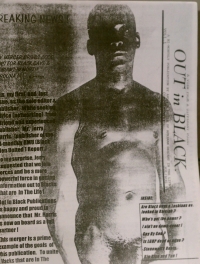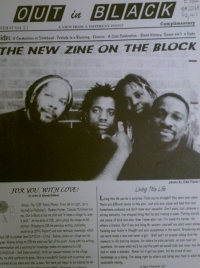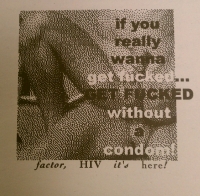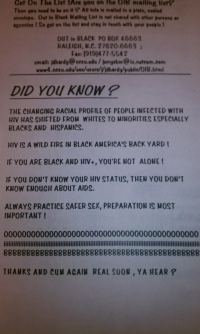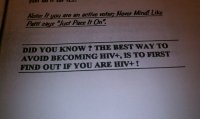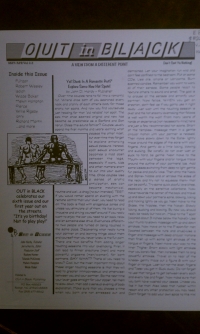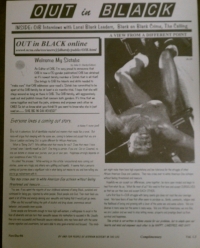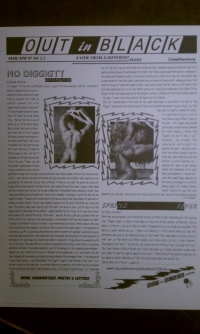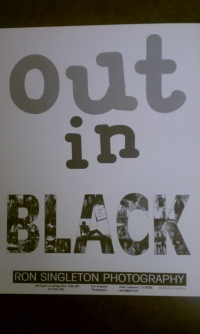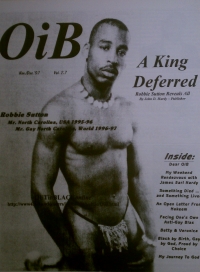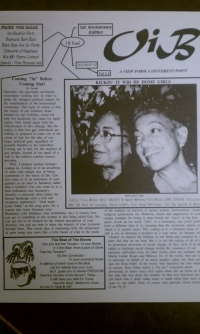Difference between revisions of "Out in Black"
| Line 1: | Line 1: | ||
| + | Representations of Black LGBT Individuals in North Carolina | ||
| + | |||
__TOC__ | __TOC__ | ||
=='''General Information'''== | =='''General Information'''== | ||
Revision as of 20:37, 23 April 2012
Representations of Black LGBT Individuals in North Carolina
General Information
Out in Black Magazine was started in July 1996 by John D. Hardy also as editor-in-chief and a number of staff writers including main writers Rodney P. Hunter, Jerry Harris, and Tolanda McKinney among numerous other featured guest writers. The publication was released bi-monthly and carried the slogan “A View From a Different Point. By and For People of Afrikan Descent in the Life.” Although Out in Black specifically claimed this slogan, its readership reached national and even global levels as the magazine received subscription requests from LGBT individuals in places such as: California, Puerto Rico, and North Korea. Among the wide array of topics discussed between the pages of Out in Black, the most commonly recurring topics and themes, which will be discussed in more detail later, were: the African-American Church, HIV/AIDs crisis and its impact on North Carolina’s Urban Communities, the concept of a singular African-American LGBT ‘Community’, and politics.
The very FIRST issue of Out in Black
The collaborations that went into this publication highlighted and stressed the goals and concerns present in North Carolina’s Black Urban, and sometimes rural communities. They effectively worked to preserve and allow the voices of numerous African-American LGBT identified individuals to be heard. The publication featured poetry from a number of readers who wrote in, sponsored books from local writers and included numbers of personal coming out stories, allegories, and other experiences ‘in the life’ that discussed everything from being infected with HIV to being ‘in the life’ but on the down low. They conducted interviews with influential activists and figures working in North Carolina on gay rights and HIV/AIDs issues and included commentary from other individuals they deemed important in the Black LGBT struggle. All in all, Out in Black represented a publication of many themes and voices working to highlight the lives and struggles of North Carolina’s Black LGBT individuals.
Major staff writers for Out in Black from left to right: Jerry Harris (co-publisher), Rodney P. Hunter, Tolanda McKinney, and John Hardy (founder & editor-in-chief). [2]
The African-American Church
The topic of religion is heavily mentioned throughout the pages of Out in Black and in a number of its issues. One of the biggest issues that arises with regards to religion is the African-American church. In the third issue of volume two, in an article titled “The African American Church,” staff writer Rodney Hunter criticizes the church due to what he perceives as its lack of interest in supporting the Black LGBT community by issuing information on safe sex and disease prevention. In one instance, he mentions:
“the black church never seems to take into consideration the fact that AIDS has taken away so many of its members which includes [sic] clergymen and other prominent members of the church. To make matters worse, as recently as 1996 was the first time I have found any literature on AIDS/HIV in the Black church and it happened to be a small 4x4 brochure on where a person might obtain private testing for HIV. Much to my disappointment there was nothing on condom usage (although Black church members are having sex) AIDS counseling or treatment and care for those with HIV or AIDS. If AIDS is ever mentioned it is in the form of condemnation and judgement [sic] for those who are infected.” [3]
Throughout issues of Out in Black there are various blurbs where individuals question the role of the church in their lives and whether or not the African-American church is playing a positive role in working to uplift the Black community. From the writings of the staff and other guest writers, it appears as if the African-American church lacked a solid foundation of support from Black LGBT individuals in the Triangle area due to its visible inactivity at the height of the HIV/AIDs crisis.
Out in Black Volume 1, Issue 2
HIV/AIDS
The issue of HIV/AIDs was probably the most significant and commonly recurring issue in Out in Black. Starting with the very first issue, the writers issued a collaborative advice section titled “WHEN A FRIEND HAS AIDS!” In this section, they issued tips that would teach LGBT individuals how to better provide emotional support for friends affected by the disease, eliminating stigmatizing those affected as well as maintaining their health and working to take care of themselves. These advice columns ran through every single issue of Out in Black, and they created pictures and other small blurbs with various safe sex reminders and information about knowing one’s HIV status. Staff writers consistently published information regarding treatment centers, places where safe sex information was available, and where new drugs would be provided for the public. Out in Black served as an extremely informative source for those sick with the disease as they continuously provided information about medical sources and community help centers for those who were affected. In volume 1, issue 3, Jerry Harris conducted an interview with Robert “Bobby” Arrington, an activist pivotal to the fight for funding and rights for those affected by HIV/AIDs. In the interview, Arrington discusses his role in taking down the AIDS Service Project (TASP) due to its goal of servicing mainly white, middle-class individuals affected by the disease, although Blacks were being affected and dying at much higher rates. Through is interview it becomes clear of the lack of tangible progress that had been made in 1996 in terms of having a single stable foundation in North Carolina working on helping inner city African-Americans educate themselves and deal with the crisis. [5]
HIV/AIDs advice present in Out in Black:
The Concept of ‘Community’
The striving for a singular, educated, and supportive Black LGBT community was repeatedly addressed in between the pages of Out in Black. In a number of articles, especially one titled “Wake up every body, it’s time to uplift our community” by staff writer Rodney P. Hunter , he addresses the fact that the Black community lacks cohesion and fails to discuss social issues that have been the most detrimental to African-Americans. He says that the Black community lacks a positive dialogue that involves educating themselves and the community; these articles represents a call for discussions about sex despite its taboo among Blacks and seeking out sex education to better uplift and lower their numbers in terms of those affected by HIV and other STDs. [9]
Selected covers of Out in Black:: Vol 2.3, Vol 1.3, and Vol 2.2
Politics
Out in Black Magazine throughout its lifetime published a vast amount of short articles and blurbs regarding the state of political affairs in North Carolina and how the LGBT community should rise up and work to effectively change policy through their activism and their numbers. In a number of issues, the writers express their extreme contempt for North Carolina Senator Jesse Helms. Jesse Helms was one of North Carolina’s leading conservative senators who had worked against a number of campaigns led by African-American citizens including, but not limited to: the national recognition of Martin Luther King Jr. Day and the passage of gay rights legislation in North Carolina. In an attempt to display their disgust and distaste for Helms, the writers termed him “Mz. Jesse Helms” commented that she had been screwing the gays for years and without any lube, referring to the pain that had been inflicted upon the Black LGBT community by Jesse Helms due to his lack of effort in pushing forth legislation that could make a positive impact in the lives of North Carolina’s Black and marginalized sexual minorities. In the very first issue of Out in Black the writers collaborated on a special titled “WHO’S GOT THE POWER?” Throughout the short article, they repeated the words “So Get off your ass and go VOTE!” in an effort to push the Black LGBT community to work for the removal of Helms and to demonstrate that with numbers they could work to influence policy in ways that had not been possible in the past. In another article titled “To Be or Not To Be? Is Still The Question” editor John Hardy discusses the state of political affairs and how the laws regarding homosexuality are changing rapidly and moving from condemnation to legitimacy. His tone is one of urgency as he calls for Blacks to stop complaining and ask why and to “build TRUST and a network that will allow [them] to flex economic power, and bypass the discrimination within [their] already oppressed gay & lesbian community.” [13] To demonstrate his disgust for Jesse Helms further he includes:
“Here in North Carolina the State Legislature has passed an amendment to prevent this state from recognizing gay & lesbian marriages. What a waste of YOUR tax dollars! Mz. Jesse is in full drag again spouting out that same old shit from the 1950’s; That No good Son Of A Bitch Must Go! This election gives us a chance to make a change. Lets do it, lets sweep the House, Senate, and City Governments clean of their BIGOTS. As a Black Gay American I hope we get Mz. Jesse and other other fools out of office. Also I hope more Black Gays & Lesbians would become involved in this movement. [sic]”
Jesse Helms was a constant subject of criticism and opposition on behalf of Out in Black writers and their readership. Politically, their main foci included changing the legislation to reflect equal opportunity and access to public services for the LGBT community and the removal of Helms.
Other photos of Out in Black Magazine:
- ↑ Picture 1: Out in Black 1.1 (1996)
- ↑ Picture 2: Out in Black 2.1 (1997)
- ↑ Hunter, Rodney P. "The African American Church." Out in Black. 2.3 (1997): n. page. Print.
- ↑ Picture 3: Out in Black 1.2 (1996)
- ↑ Arrington, Robert. Personal Interview. Out in Black Nov 1996.
- ↑ Picture 4: Out in Black 2.3 (1997)
- ↑ Picture 5: Out in Black 1.3 (1996)
- ↑ Picture 6: Out in Black 1.1 (1996)
- ↑ Hunter, Rodney P. “Wake up every body, it’s time to uplift our community.” Out in Black 1.2 (1996): n. page. Print.
- ↑ Picture 7: Out in Black 2.3 (1997)
- ↑ Picture 8: Out in Black 1.3 (1996)
- ↑ Picture 9: Out in Black 2.2 (1997)
- ↑ Hardy, John. “To Be or Not To Be? Is Still The Question” Out in Black (1996): n. page. Print.
- ↑ Picture 10: Out in Black 2.3 (1997)
- ↑ Picture 11: Out in Black 2.7 (1997)
- ↑ Picture 12: Out in Black 2.4 (1997)
CREATED BY: ZINA SCOTT-PAYNE
